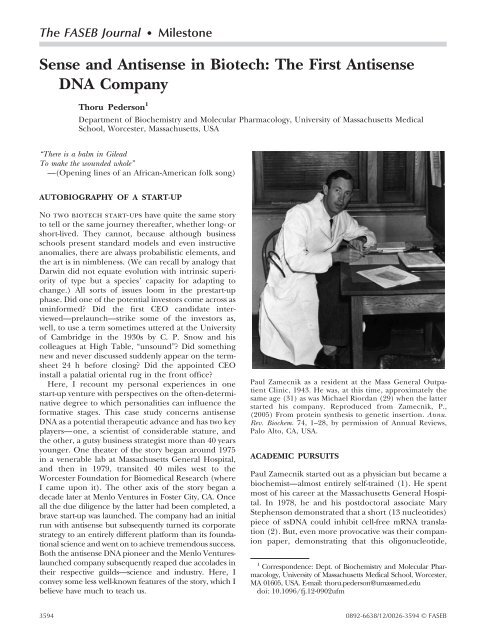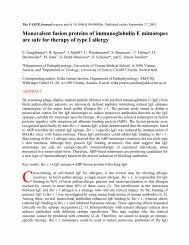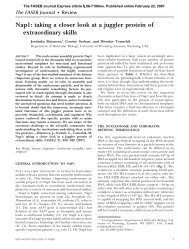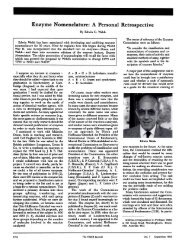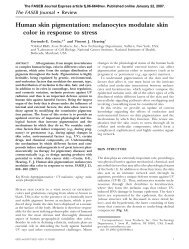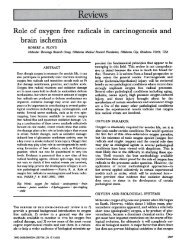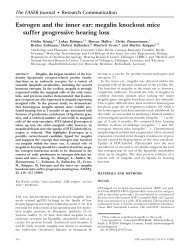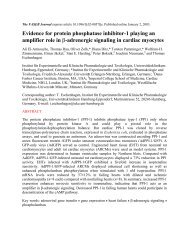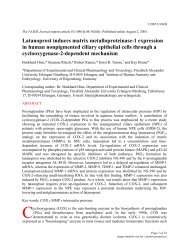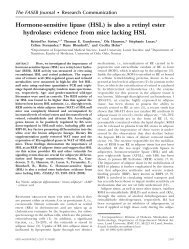Sense and Antisense in Biotech: The First Antisense DNA Company
Sense and Antisense in Biotech: The First Antisense DNA Company
Sense and Antisense in Biotech: The First Antisense DNA Company
You also want an ePaper? Increase the reach of your titles
YUMPU automatically turns print PDFs into web optimized ePapers that Google loves.
<strong>The</strong> FASEB Journal Milestone<br />
<strong>Sense</strong> <strong>and</strong> <strong>Antisense</strong> <strong>in</strong> <strong>Biotech</strong>: <strong>The</strong> <strong>First</strong> <strong>Antisense</strong><br />
<strong>DNA</strong> <strong>Company</strong><br />
Thoru Pederson 1<br />
Department of Biochemistry <strong>and</strong> Molecular Pharmacology, University of Massachusetts Medical<br />
School, Worcester, Massachusetts, USA<br />
“<strong>The</strong>re is a balm <strong>in</strong> Gilead<br />
To make the wounded whole”<br />
—(Open<strong>in</strong>g l<strong>in</strong>es of an African-American folk song)<br />
AUTOBIOGRAPHY OF A START-UP<br />
No two biotech start-ups have quite the same story<br />
to tell or the same journey thereafter, whether long- or<br />
short-lived. <strong>The</strong>y cannot, because although bus<strong>in</strong>ess<br />
schools present st<strong>and</strong>ard models <strong>and</strong> even <strong>in</strong>structive<br />
anomalies, there are always probabilistic elements, <strong>and</strong><br />
the art is <strong>in</strong> nimbleness. (We can recall by analogy that<br />
Darw<strong>in</strong> did not equate evolution with <strong>in</strong>tr<strong>in</strong>sic superiority<br />
of type but a species’ capacity for adapt<strong>in</strong>g to<br />
change.) All sorts of issues loom <strong>in</strong> the prestart-up<br />
phase. Did one of the potential <strong>in</strong>vestors come across as<br />
un<strong>in</strong>formed? Did the first CEO c<strong>and</strong>idate <strong>in</strong>terviewed—prelaunch—strike<br />
some of the <strong>in</strong>vestors as,<br />
well, to use a term sometimes uttered at the University<br />
of Cambridge <strong>in</strong> the 1930s by C. P. Snow <strong>and</strong> his<br />
colleagues at High Table, “unsound”? Did someth<strong>in</strong>g<br />
new <strong>and</strong> never discussed suddenly appear on the termsheet<br />
24 h before clos<strong>in</strong>g? Did the appo<strong>in</strong>ted CEO<br />
<strong>in</strong>stall a palatial oriental rug <strong>in</strong> the front office?<br />
Here, I recount my personal experiences <strong>in</strong> one<br />
start-up venture with perspectives on the often-determ<strong>in</strong>ative<br />
degree to which personalities can <strong>in</strong>fluence the<br />
formative stages. This case study concerns antisense<br />
<strong>DNA</strong> as a potential therapeutic advance <strong>and</strong> has two key<br />
players—one, a scientist of considerable stature, <strong>and</strong><br />
the other, a gutsy bus<strong>in</strong>ess strategist more than 40 years<br />
younger. One theater of the story began around 1975<br />
<strong>in</strong> a venerable lab at Massachusetts General Hospital,<br />
<strong>and</strong> then <strong>in</strong> 1979, transited 40 miles west to the<br />
Worcester Foundation for Biomedical Research (where<br />
I came upon it). <strong>The</strong> other axis of the story began a<br />
decade later at Menlo Ventures <strong>in</strong> Foster City, CA. Once<br />
all the due diligence by the latter had been completed, a<br />
brave start-up was launched. <strong>The</strong> company had an <strong>in</strong>itial<br />
run with antisense but subsequently turned its corporate<br />
strategy to an entirely different platform than its foundational<br />
science <strong>and</strong> went on to achieve tremendous success.<br />
Both the antisense <strong>DNA</strong> pioneer <strong>and</strong> the Menlo Ventureslaunched<br />
company subsequently reaped due accolades <strong>in</strong><br />
their respective guilds—science <strong>and</strong> <strong>in</strong>dustry. Here, I<br />
convey some less well-known features of the story, which I<br />
believe have much to teach us.<br />
Paul Zamecnik as a resident at the Mass General Outpatient<br />
Cl<strong>in</strong>ic, 1943. He was, at this time, approximately the<br />
same age (31) as was Michael Riordan (29) when the latter<br />
started his company. Reproduced from Zamecnik, P.,<br />
(2005) From prote<strong>in</strong> synthesis to genetic <strong>in</strong>sertion. Annu.<br />
Rev. Biochem. 74, 1–28, by permission of Annual Reviews,<br />
Palo Alto, CA, USA.<br />
ACADEMIC PURSUITS<br />
Paul Zamecnik started out as a physician but became a<br />
biochemist—almost entirely self-tra<strong>in</strong>ed (1). He spent<br />
most of his career at the Massachusetts General Hospital.<br />
In 1978, he <strong>and</strong> his postdoctoral associate Mary<br />
Stephenson demonstrated that a short (13 nucleotides)<br />
piece of ss<strong>DNA</strong> could <strong>in</strong>hibit cell-free mRNA translation<br />
(2). But, even more provocative was their companion<br />
paper, demonstrat<strong>in</strong>g that this oligonucleotide,<br />
1 Correspondence: Dept. of Biochemistry <strong>and</strong> Molecular Pharmacology,<br />
University of Massachusetts Medical School, Worcester,<br />
MA 01605, USA. E-mail: thoru.pederson@umassmed.edu<br />
doi: 10.1096/fj.12-0902ufm<br />
3594 0892-6638/12/0026-3594 © FASEB
added to the cell culture medium, also <strong>in</strong>hibited the<br />
replication of Rous sarcoma virus (RSV) <strong>in</strong> <strong>in</strong>tact<br />
cells (3). Zamecnik tried to conv<strong>in</strong>ce Mass General to<br />
seek patent protection, but the <strong>in</strong>stitution deferred.<br />
Presumably, the rights then went to him, but he did<br />
not pursue them with the U.S. Patent <strong>and</strong> Trademark<br />
Office as far as we know. Meanwhile, 1 year before—<strong>in</strong><br />
1977—another key event had occurred.<br />
Zamecnik turned 65 <strong>and</strong> thus, came up aga<strong>in</strong>st the<br />
Harvard Medical School’s strict retirement policy. In<br />
an impassioned letter to the dean, Zamecnik made a<br />
case for side-stepp<strong>in</strong>g the retirement rule, but the<br />
adm<strong>in</strong>istration held to the policy. In one of the most<br />
ironic <strong>and</strong> fasc<strong>in</strong>at<strong>in</strong>g twists <strong>in</strong> this story, Zamecnik<br />
actually had the f<strong>in</strong>al satisfaction, 20 years later, as we<br />
shall see.<br />
Reaction to the two papers by Zamecnik <strong>and</strong> Stephenson<br />
was mixed. At this time, I was at the Worcester<br />
Foundation, a research <strong>in</strong>stitute <strong>in</strong> Shrewsbury, MA,<br />
<strong>and</strong> had <strong>in</strong> those years gotten to meet Zamecnik on<br />
several occasions, as he was on the foundation’s Board<br />
of Trustees. A few months after his 1978 papers came<br />
out, I went to see him to encourage the use of <strong>in</strong> vivo<br />
psoralen-mediated <strong>DNA</strong>-RNA cross-l<strong>in</strong>k<strong>in</strong>g to capture<br />
his oligo <strong>in</strong> its base-pair<strong>in</strong>g to the target RSV RNA. My<br />
lab was us<strong>in</strong>g this approach for other purposes at the<br />
time (4), <strong>and</strong> I was reasonably optimistic that the<br />
method could detect the base-pair<strong>in</strong>g of his oligo with<br />
its RNA target, <strong>and</strong> this would thus be an <strong>in</strong> vivo<br />
confirmation of the envisioned event. I thought this<br />
experiment could overcome the legions of skeptics at<br />
the time. So, on the morn<strong>in</strong>g of our scheduled meet<strong>in</strong>g,<br />
I w<strong>and</strong>ered <strong>in</strong>to Mass General th<strong>in</strong>k<strong>in</strong>g of all the<br />
great medic<strong>in</strong>e <strong>and</strong> medical science that had been<br />
done under its roof <strong>and</strong> began to th<strong>in</strong>k, “What am I<br />
do<strong>in</strong>g here?” (My angst was ma<strong>in</strong>ly because I had never<br />
studied medic<strong>in</strong>e, <strong>and</strong> I felt an imposter <strong>in</strong> such<br />
hallowed halls.) I found Zamecnik’s location, <strong>and</strong> we<br />
sat down at a battleship gray desk <strong>in</strong> a dusky hallway,<br />
leav<strong>in</strong>g me to ponder if this was <strong>in</strong> fact the office of the<br />
Collis P. Hunt<strong>in</strong>gton professor of Harvard Medical<br />
School? (It may not have been his real office but simply<br />
a convenient place for us to sit down, yet it may have<br />
been a prescient sett<strong>in</strong>g, for I later learned that he<br />
never sought adornments or embellishments <strong>in</strong> his<br />
office.) He clearly understood the psoralen cross-l<strong>in</strong>k<strong>in</strong>g<br />
idea, but he cordially deferred do<strong>in</strong>g the experiment,<br />
say<strong>in</strong>g that his group had too many other th<strong>in</strong>gs<br />
underway at the time. As I left for the elevator, I had a<br />
sudden realization: he wasn’t worried that he was<br />
wrong! This attribute (extreme confidence but not<br />
arrogance) has often been noted by historians of<br />
science when decipher<strong>in</strong>g the sheer determ<strong>in</strong>ation of<br />
visionaries. <strong>The</strong> late Judah Folkman once wrote that<br />
this trait, i.e., be<strong>in</strong>g sure (or at least 95% sure) at the<br />
outset, can pa<strong>in</strong>t one’s subsequent pursuit of the idea as<br />
either admirable persistence or bulldog obst<strong>in</strong>acy, depend<strong>in</strong>g<br />
on the lens of the observer (5).<br />
SENSE AND ANTISENSE IN BIOTECH<br />
cis/trans AT THE NIH<br />
Zamecnik <strong>and</strong> his group had played a sem<strong>in</strong>al role <strong>in</strong><br />
open<strong>in</strong>g up the entire field of molecular biology by<br />
ref<strong>in</strong><strong>in</strong>g cell-free prote<strong>in</strong> synthesis <strong>and</strong> discover<strong>in</strong>g<br />
am<strong>in</strong>o acid activation <strong>and</strong> transfer RNA (1). Now, 20<br />
years later, he had made yet another major discovery—<br />
the first embodiment of antisense <strong>DNA</strong>—<strong>and</strong> so, he was<br />
underst<strong>and</strong>ably dispirited by the retirement policy of<br />
his <strong>in</strong>stitution, one to which he had given so much time<br />
over the years on numerous committees (notably, Mass<br />
General’s Executive Committee, which he once told<br />
consumed one-third of his time) <strong>and</strong> other substantial<br />
roles beyond his own laboratory. He promptly sought<br />
<strong>and</strong> received a Fogarty Fellowship to spend 1 year at<br />
NIH, dur<strong>in</strong>g which he pondered his options. At 65,<br />
Zamecnik was still physically robust <strong>and</strong> as athletically<br />
<strong>in</strong>cl<strong>in</strong>ed as always, so he looked around the NIH<br />
campus for potential tennis partners. He later told me<br />
that he <strong>and</strong> several NIH scientists had jo<strong>in</strong>tly <strong>and</strong><br />
amicably “<strong>in</strong>terviewed each other at the net” (a sort of<br />
cis-trans test, to use the genetics metaphor). After a few<br />
games <strong>in</strong> trans, Zamecnik <strong>and</strong> one partner became cis.<br />
<strong>The</strong> mutually chosen partner was Robert Gallo. This<br />
conjunction turned out to be a profound event.<br />
CALLING HOME<br />
As his NIH Fogarty year was draw<strong>in</strong>g to a close, Zamecnik<br />
wrote to his former post doc Mahlon Hoagl<strong>and</strong>,<br />
who had discovered transfer RNA <strong>in</strong> 1958 when work<strong>in</strong>g<br />
<strong>in</strong> Zamecnik’s group. Hoagl<strong>and</strong> was now president<br />
of the Worcester Foundation for Experimental Biology<br />
<strong>and</strong> was well along <strong>in</strong> redirect<strong>in</strong>g the <strong>in</strong>stitution from its<br />
orig<strong>in</strong>al fame <strong>in</strong> endocr<strong>in</strong>e <strong>and</strong> reproductive biology—<br />
hav<strong>in</strong>g played a key role <strong>in</strong> both the birth control pill<br />
<strong>and</strong> <strong>in</strong> vitro fertilization—<strong>in</strong>to molecular biology <strong>and</strong><br />
cancer research. In this curious reversal of their previous<br />
roles, Zamecnik was now ask<strong>in</strong>g his former post doc<br />
to take him <strong>in</strong>.<br />
<strong>The</strong> antisense <strong>DNA</strong> research program that Zamecnik<br />
wrote up was seen by everyone with whom Hoagl<strong>and</strong><br />
consulted (<strong>in</strong>clud<strong>in</strong>g myself) as powerfully promis<strong>in</strong>g,<br />
<strong>and</strong> he was enthusiastically <strong>in</strong>vited to come. (<strong>The</strong><br />
write-up Zamecnik had prepared had, at the top, a<br />
phrase <strong>in</strong> his h<strong>and</strong>writ<strong>in</strong>g that I have always remembered:<br />
“Dear Mahlon, Of course, this reads like a<br />
novel”.) Zamecnik’s pioneer<strong>in</strong>g work on prote<strong>in</strong> synthesis<br />
at Mass General had been funded by a longst<strong>and</strong><strong>in</strong>g<br />
grant from the Atomic Energy Commission, <strong>and</strong> on<br />
his arrival at the Worcester Foundation, a very softmoney<br />
<strong>in</strong>stitution, the issue arose as to how he <strong>and</strong>/or<br />
the <strong>in</strong>stitution would now fund his promis<strong>in</strong>g ideas<br />
about antisense <strong>DNA</strong>. He soon obta<strong>in</strong>ed a grant from<br />
the National Institute of General Medical Sciences, <strong>and</strong><br />
his lab was also supported <strong>in</strong> part by a National Cancer<br />
Institute (NCI) “Core” grant that Hoagl<strong>and</strong> had won <strong>in</strong><br />
1971 <strong>and</strong> that I had successfully renewed as thendirector<br />
of our Cancer Center. Later, after I succeeded<br />
3595
Hoagl<strong>and</strong> as president of the Worcester Foundation, I<br />
was able to obta<strong>in</strong> support for Zamecnik’s program<br />
from the Mathers Foundation, <strong>and</strong> both he <strong>and</strong> I were<br />
always grateful for the risk that they were will<strong>in</strong>g to take<br />
(very much their ken at the time <strong>and</strong> still so today).<br />
At the Worcester Foundation, Zamecnik pursued a<br />
number of projects that were all proceed<strong>in</strong>g well, until<br />
his former tennis partner encouraged him to consider<br />
a new target for his antisense <strong>DNA</strong> approach—a virus<br />
that had just been discovered <strong>in</strong> isolates from patients<br />
afflicted with a newly recognized immunodeficiency<br />
disease. This was human T cell lymphotropic virus III,<br />
soon to be known as HIV <strong>and</strong>, shortly thereafter,<br />
established as the etiological agent of AIDS.<br />
HIV AS A TARGET?<br />
Given that Zamecnik’s <strong>in</strong>itial publication (3) had been<br />
with a retrovirus, Gallo’s suggestion didn’t need much<br />
<strong>in</strong>cubation time. Zamecnik immediately turned his lab<br />
full-bore to antisense <strong>in</strong>hibition of HIV <strong>in</strong> <strong>in</strong>fected cells.<br />
<strong>The</strong> synthesis of oligodeoxynucleotides was now far<br />
more facile <strong>and</strong> less expensive than it had been <strong>in</strong> 1976<br />
when Zamecnik <strong>and</strong> Stephenson performed their classic<br />
studies—this due to pioneer<strong>in</strong>g advances, notably by<br />
Robert Lets<strong>in</strong>ger <strong>and</strong> Marv<strong>in</strong> Caruthers.<br />
In 1986, Zamecnik <strong>and</strong> colleagues (6) reported the<br />
<strong>in</strong>hibition of HIV replication <strong>in</strong> cell culture by an<br />
antisense oligo. Although he enjoyed, as a member of<br />
the National Academy of Sciences, the privilege of<br />
submitt<strong>in</strong>g his paper directly, he asked me <strong>and</strong> I<br />
suspect others, <strong>in</strong>clud<strong>in</strong>g Gallo, to read the manuscript.<br />
I marked it up more than I probably needed to <strong>and</strong><br />
gave him a bit of a hard time here <strong>and</strong> there. This was<br />
one of the few times when we didn’t agree (there was<br />
another, which is the basis of this story, to come). I felt<br />
that the results were conv<strong>in</strong>c<strong>in</strong>g but that the broader<br />
therapeutic potential had been pitched a bit too ambitiously<br />
(or <strong>in</strong> fairness to Zamecnik, maybe one could<br />
say, “too optimistically”). I also thought the co<strong>in</strong><strong>in</strong>g of<br />
the term “hybridon” for the envisioned oligo:target<br />
RNA duplex was a reach. <strong>The</strong> results at the time did<br />
not, at least <strong>in</strong> my m<strong>in</strong>d, demonstrate a mechanism of<br />
sufficient clarity <strong>and</strong> cogency as to earn equal stature<br />
with the venerable terms “codon” <strong>and</strong> “operon”, biblical<br />
concepts <strong>in</strong> molecular biology to which I felt<br />
Zamecnik’s results should not yet be added by co<strong>in</strong><strong>in</strong>g<br />
another such sacred-look<strong>in</strong>g term <strong>in</strong> the nomenclature<br />
of biological <strong>in</strong>formation transfer/suppression. To his<br />
credit, Zamecnik <strong>and</strong> coauthors thoughtfully responded<br />
to most of my po<strong>in</strong>ts.<br />
Zamecnik often remarked how repr<strong>in</strong>ts of the two<br />
1978 papers he had ordered had turned yellow on his<br />
office shelf as few requests arrived (this was of course<br />
many years before the Internet <strong>and</strong> PubMed). But, the<br />
1986 HIV paper generated much more buzz. This was<br />
the era of still-embryonic but empathically zealous<br />
searches for plausible approaches to antiretroviral therapy<br />
for AIDS patients. For example, at this time Sam<br />
Broder <strong>and</strong> colleagues at the NCI were rac<strong>in</strong>g ahead <strong>in</strong><br />
studies that would become the basis of the first effective<br />
anti-HIV therapy, exp<strong>and</strong><strong>in</strong>g on the Nobel Prize-w<strong>in</strong>n<strong>in</strong>g<br />
work on nucleoside analog drugs by Gertrude<br />
Elion <strong>and</strong> George Hitch<strong>in</strong>gs decades earlier. Also at<br />
work at NCI was Jack Cohen, a talented nucleic acid<br />
chemist <strong>and</strong> structural biologist, who was explor<strong>in</strong>g<br />
oligodeoxynucleotide backbone modifications of various<br />
k<strong>in</strong>ds that might, it was thought then, have superior<br />
pharmacok<strong>in</strong>etics, bioavailability, <strong>and</strong> maybe even enhanced<br />
molecular action. (We shall encounter Drs.<br />
Broder <strong>and</strong> Cohen aga<strong>in</strong> <strong>in</strong> this story.)<br />
REDUCTION TO PRACTICE<br />
By now, Zamecnik’s notion of antisense <strong>DNA</strong> had been<br />
elevated from skeptical scold<strong>in</strong>gs he had endured from<br />
“experts” to a degree of recognition, <strong>in</strong> part, as a result<br />
of the widely acclaimed success, already at h<strong>and</strong>, of the<br />
antisense <strong>DNA</strong> method for knock<strong>in</strong>g down mRNA<br />
expression <strong>in</strong> at least cultured cells <strong>and</strong> certa<strong>in</strong> animal<br />
experiments as well. From the st<strong>and</strong>po<strong>in</strong>t of epistemology,<br />
note that Zamecnik had no role <strong>in</strong> the application<br />
of antisense <strong>DNA</strong> to the knockdown of cellular mRNAs,<br />
an application that brought the antisense <strong>DNA</strong> concept<br />
more fame than did its therapeutic promise (exactly as<br />
was the case years later for small <strong>in</strong>terfer<strong>in</strong>g RNAs as<br />
knockdown agents <strong>in</strong> cells relative to imag<strong>in</strong>ed therapeutic<br />
applications). Zamecnik was never <strong>in</strong>terested <strong>in</strong><br />
mRNA knockdown as a lab tool, regard<strong>in</strong>g it as a<br />
sideshow, glad to see this application but not waver<strong>in</strong>g<br />
from his own mission: antisense <strong>DNA</strong> as medic<strong>in</strong>e. As I<br />
have said elsewhere (1), Paul Zamecnik was unique<br />
among the pioneers of molecular biology <strong>in</strong> that he<br />
never stopped th<strong>in</strong>k<strong>in</strong>g like a physician.<br />
LEARNING THE BUSINESS<br />
Meanwhile, a surpris<strong>in</strong>g th<strong>in</strong>g happened at the Worcester<br />
Foundation. I had come <strong>in</strong> 1971, recruited by<br />
Mahlon Hoagl<strong>and</strong>. Zamecnik had come <strong>in</strong> 1979, also<br />
recruited by Hoagl<strong>and</strong>. On Hoagl<strong>and</strong>’s announcement<br />
<strong>in</strong> 1984 that he would retire 1 year later, a search<br />
committee, led by Harvard microbiologist Bernard<br />
Davis, tapped me to be the next president of the<br />
<strong>in</strong>stitution. I asked Alex Rich [Massachusetts Institute<br />
of Technology (MIT)], a member of the search committee,<br />
for advice. He said, “You can do it <strong>and</strong> your<br />
science too—the Worcester Foundation needs a leader<br />
who can do both”. Thus, <strong>in</strong> a bizarre scenario, I became<br />
Zamecnik’s “boss” on the retirement of his former post<br />
doc who had preceded me as president of the Worcester<br />
Foundation. Add<strong>in</strong>g to the irony was that with my<br />
expertise also be<strong>in</strong>g RNA, Zamecnik <strong>and</strong> I cont<strong>in</strong>ued to<br />
be extremely conversant <strong>and</strong> personally close, with our<br />
employer-employee relationship mutually regarded as<br />
rather absurd, although he was—always the gentleman—dutiful<br />
to the formal requirements of the em-<br />
3596 Vol. 26 September 2012 <strong>The</strong> FASEB Journal www.fasebj.org<br />
PEDERSON
ployer-employee axis, as I have detailed elsewhere <strong>in</strong><br />
some amus<strong>in</strong>g vignettes (1). His lab <strong>and</strong> m<strong>in</strong>e even<br />
collaborated <strong>and</strong> published together on one occasion,<br />
which was both fun <strong>and</strong> yet a bit contentious when we<br />
were writ<strong>in</strong>g the paper. Our different writ<strong>in</strong>g/presentation<br />
styles aside, this project <strong>and</strong> publication turned<br />
out to have been a good idea (7).<br />
Well before the 1986 paper (6), it had become clear<br />
to both Zamecnik <strong>and</strong> me that his antisense <strong>DNA</strong> work,<br />
especially the HIV axis, might warrant a start-up company.<br />
I was worried about the lack of an issued patent,<br />
th<strong>in</strong>k<strong>in</strong>g that Zamecnik’s 1986 paper might be deemed<br />
obvious <strong>in</strong> light of his (unpatented) 1978 disclosure of<br />
the core idea <strong>and</strong> art of enablement. Yet, I also felt that<br />
the HIV paper had use “written all over it”, <strong>and</strong> <strong>in</strong> at<br />
least U.S. law, this feature can often reign <strong>in</strong> patent<br />
claim allowances.<br />
<strong>The</strong> Worcester Foundation did not have a formal<br />
patent <strong>in</strong>come-allocation policy at the time, nor did<br />
we even have a policy that required our scientists to<br />
assign their rights to the <strong>in</strong>stitution (although I soon<br />
<strong>in</strong>troduced both). Zamecnik was consistently attentive<br />
to the ways the Worcester Foundation might<br />
benefit if his idea became the basis of licensed<br />
<strong>in</strong>tellectual property. I believe this reflected his prior<br />
association with the Worcester Foundation as a<br />
trustee, as well as his gratitude to Hoagl<strong>and</strong> for<br />
hav<strong>in</strong>g taken him <strong>in</strong>. I had also directed some<br />
discretionary funds to his lab after becom<strong>in</strong>g president<br />
<strong>and</strong> was very much beh<strong>in</strong>d his program <strong>in</strong> all<br />
ways, <strong>in</strong>clud<strong>in</strong>g with our trustees <strong>and</strong> donors, <strong>and</strong> I<br />
th<strong>in</strong>k he was grateful for that.<br />
START-UP, OR NOT<br />
Zamecnik’s son is a banker, <strong>and</strong> they were both connected<br />
to their respective A-lists of Boston Brahm<strong>in</strong><br />
gr<strong>and</strong>ees, plus his son had some <strong>in</strong>ternational connections.<br />
Zamecnik also had numerous contacts <strong>in</strong> pharma<br />
who had been medical students, fellows, or house<br />
officers at Mass General, <strong>and</strong> he began conversations<br />
with many of them. By 1987–88, we were both aware<br />
that antisense <strong>DNA</strong> was on the start-up l<strong>and</strong>scape, but<br />
as we later realized, we were not as well connected to<br />
big pharma or the blue-ribbon venture community as<br />
he thought or as I <strong>in</strong>nocently had assumed that we<br />
might be based on his contacts. But R&D representatives<br />
from Merck, Bristol-Myers Squibb, <strong>and</strong> other large<br />
companies were will<strong>in</strong>g to come <strong>and</strong> visit us at the<br />
Worcester Foundation, <strong>and</strong> Zamecnik <strong>and</strong> I also went<br />
to New York to visit a number of banks <strong>and</strong> venture<br />
groups, among which I recall Rothschild Ventures as<br />
be<strong>in</strong>g the most engaged. We also had a visit from<br />
Hambrecht & Quist, <strong>and</strong> my recollection is that Zamecnik<br />
didn’t th<strong>in</strong>k they understood the science. However,<br />
neither Zamecnik nor I had developed a full-scale<br />
bus<strong>in</strong>ess plan (one of our key mistakes), so all of these<br />
companies, banks, <strong>and</strong> venture groups saw us as amateurs—a<br />
charm<strong>in</strong>g <strong>and</strong> brilliant scientist with some<br />
SENSE AND ANTISENSE IN BIOTECH<br />
provocative lab results <strong>and</strong> the cheerful head of his<br />
<strong>in</strong>stitution tagg<strong>in</strong>g along. Also, the Worcester Foundation<br />
had no analogues of Stanford’s Niels Reimer or<br />
MIT’s John Preston sitt<strong>in</strong>g <strong>in</strong> <strong>and</strong> advis<strong>in</strong>g us. In<br />
retrospect, how I wish we had had such m<strong>in</strong>ds at the<br />
table at the time. In October 1988, when Zamecnik <strong>and</strong><br />
the Worcester Foundation had reached a zenith <strong>in</strong><br />
their dyspepsia over how to commercialize antisense<br />
<strong>DNA</strong>, I sought a meet<strong>in</strong>g with MIT’s John Preston, who<br />
was good enough to meet with me <strong>and</strong> offer advice.<br />
This led me <strong>in</strong>to a longst<strong>and</strong><strong>in</strong>g relationship with<br />
Preston’s successor, Lita Nelsen, who, like Preston,<br />
shared valuable time with me, even though I was not at<br />
MIT nor was this MIT <strong>in</strong>tellectual property. Nelsen’s<br />
generous will<strong>in</strong>gness to help me th<strong>in</strong>k through the<br />
start-up situation <strong>and</strong> later, licens<strong>in</strong>g issues is someth<strong>in</strong>g<br />
for which I shall be forever grateful to her.<br />
ALMOST THE FIRST ANTISENSE <strong>DNA</strong><br />
COMPANY<br />
<strong>The</strong> Worcester Foundation, of course, had filed a<br />
patent application prior to Zamecnik’s HIV publication,<br />
<strong>and</strong> by mid-1988, we had gotten an Allowance of<br />
Claims, lead<strong>in</strong>g us to start a different conversation with<br />
potential <strong>in</strong>vestors, given that some degree of patent<br />
protection was now a realistic possibility. Thus armed,<br />
Zamecnik <strong>and</strong> I, together or <strong>in</strong> other cases on our own,<br />
embarked on another round of discussions with<br />
pharma <strong>and</strong> banks but still with the same headaches<br />
after every meet<strong>in</strong>g. But then, Zamecnik came upon a<br />
Harvard Medical School-launched venture fund. It was<br />
<strong>in</strong>itially called Ion Corp., but by the time Zamecnik<br />
contacted the company, it was known as Medical Science<br />
Partners. Harvard Medical School’s idea was to have<br />
this entity provide, or help provide, access to seed capital<br />
to nucleate start-ups based on the <strong>in</strong>stitution’s <strong>in</strong>ventors<br />
<strong>and</strong> licensable technology. Zamecnik’s courtship of Medical<br />
Science Partners was technically off-base, as he was no<br />
longer at Harvard, nor did it hold any rights to his<br />
<strong>in</strong>ventions. However, Zamecnik was still an emeritus professor<br />
at Harvard Medical School, <strong>and</strong> this got him access<br />
(conversationally, at least) to Medical Science Partners.<br />
We had several meet<strong>in</strong>gs with its partners, André Lamotte<br />
<strong>and</strong> Joseph Lovett, <strong>and</strong> Zamecnik <strong>and</strong> I both felt<br />
that this was look<strong>in</strong>g like a productive axis of conversation.<br />
Yet, Zamecnik had been bitterly disappo<strong>in</strong>ted by<br />
the reaction of pharma, as well as the negativity of the<br />
banks that we had visited <strong>in</strong> Manhattan. As is often as<br />
the case with an <strong>in</strong>ventor <strong>and</strong> visionary, he saw his<br />
concept as a perfect Aristotelian-Cartesian reality, but I<br />
viewed it, from my own nucleic acid expertise, as a very<br />
high mounta<strong>in</strong>, not as lab science but <strong>in</strong> the cl<strong>in</strong>ic.<br />
However, I had to put aside my concerns about antisense<br />
as medic<strong>in</strong>e, because as president of the Worcester<br />
Foundation, I had the responsibility to do everyth<strong>in</strong>g<br />
that I could to turn his work <strong>in</strong>to both an entity to<br />
hopefully, <strong>in</strong> some possible way, improve the human<br />
condition <strong>and</strong> also, to potentially return some money to<br />
3597
an <strong>in</strong>stitution that had given the world the birth control<br />
pill with no patent protection <strong>and</strong> thus, no royalties.<br />
As we cont<strong>in</strong>ued to keep the conversation with<br />
Medical Science Partners go<strong>in</strong>g, one morn<strong>in</strong>g, Zamecnik<br />
told me that he had been contacted by someone<br />
named Michael Riordan, who wanted to come <strong>and</strong> visit.<br />
Riordan had graduated from Wash<strong>in</strong>gton University <strong>in</strong><br />
1979 <strong>and</strong> from Johns Hopk<strong>in</strong>s School of Medic<strong>in</strong>e <strong>in</strong><br />
1984. He had then been a free-lance consultant for 1<br />
year <strong>and</strong> <strong>in</strong> 1986, had jo<strong>in</strong>ed Menlo Ventures, <strong>in</strong> Menlo<br />
Park, CA. In addition to mention<strong>in</strong>g these credentials,<br />
Riordan had faxed Zamecnik an article that he had<br />
published, <strong>in</strong> which he speculated how cell-free prote<strong>in</strong><br />
synthesis might be scaled up for pharmaceutical production<br />
of therapeutic polypeptides. This article obviously<br />
struck a chord with Zamecnik (it was very well<br />
done), <strong>and</strong> both of us thought Riordan looked good.<br />
So, we <strong>in</strong>vited him to come to the Worcester Foundation.<br />
<strong>The</strong> first meet<strong>in</strong>g took place on June 4, 1987, <strong>and</strong><br />
led to a second one on June 29th. Zamecnik <strong>and</strong> I saw<br />
immediately that Riordan was very bright <strong>and</strong> extremely<br />
well-<strong>in</strong>formed, but there, our reactions diverged.<br />
Zamecnik was unsure of Riordan’s cash position<br />
<strong>and</strong> also thought <strong>in</strong> conversations we had after the<br />
visit, that Riordan was too young to know much <strong>and</strong><br />
didn’t have credentials <strong>in</strong> science. I had an entirely<br />
different reaction. I figured we would look <strong>in</strong>to him <strong>in</strong><br />
our own due diligence, as well as the quality <strong>and</strong> cash of<br />
Menlo Ventures at the next step. I also thought that the<br />
fact that someone who actually knew molecular biology<br />
had sought Zamecnik out was noteworthy (a reversal of<br />
all of our previous knock<strong>in</strong>g-on-doors efforts). I also<br />
recognized that Riordan was still survey<strong>in</strong>g the antisense<br />
<strong>DNA</strong> l<strong>and</strong>scape <strong>and</strong> was not necessarily to be<br />
viewed as a potential partner. Zamecnik was view<strong>in</strong>g<br />
Riordan as a possible <strong>in</strong>vestor <strong>in</strong> a company, which<br />
Zamecnik would form, plugg<strong>in</strong>g the <strong>in</strong>vested dollars<br />
(from Riordan) <strong>in</strong>to his (Zamecnik’s) start-up scheme<br />
but not Riordan’s, although I sensed from the start that<br />
Riordan had all of the capital to start his own company.<br />
As I reflect back on that time, now 25 years later, I<br />
realize that Zamecnik was, from his goal perspective,<br />
duly wary of both “scientific dilution” <strong>and</strong> equity dilution,<br />
whereas I thought Riordan was check<strong>in</strong>g out the<br />
entire antisense l<strong>and</strong>scape <strong>and</strong> figur<strong>in</strong>g out what, if<br />
anyth<strong>in</strong>g, he might need to license <strong>in</strong>. Thus, I was<br />
ma<strong>in</strong>ly th<strong>in</strong>k<strong>in</strong>g of how the Worcester Foundation’s<br />
pend<strong>in</strong>g patent could be licensed. Riordan <strong>and</strong> his<br />
plans were the best th<strong>in</strong>g I had seen, <strong>and</strong> <strong>in</strong> this respect,<br />
I had to separate my roles as Zamecnik’s colleague from<br />
my duty to the Worcester Foundation as president.<br />
AN OLFACTORY VISIT<br />
When Riordan came to visit Zamecnik <strong>and</strong> me at the<br />
Worcester Foundation, neither of us knew how deeply<br />
he had already dug <strong>in</strong>to the science <strong>and</strong> promise of<br />
antisense <strong>DNA</strong>. When he first entered Zamecnik’s lab,<br />
he said, “I smell Beaucage reagent”. At this time <strong>in</strong> the<br />
antisense <strong>DNA</strong> field, there was a prevail<strong>in</strong>g idea that<br />
replac<strong>in</strong>g one of the nonbridg<strong>in</strong>g oxygens <strong>in</strong> the phosphodiester<br />
bond with a sulfur atom would attenuate the<br />
metabolic destruction of oligodeoxynucleotides <strong>in</strong> the<br />
bloodstream. <strong>The</strong> pioneer<strong>in</strong>g work had been done by<br />
Wojciech Stec <strong>in</strong> Lodz, Pol<strong>and</strong>, <strong>and</strong> the chemistry<br />
<strong>in</strong>volves a reactant (Fig. 1A), named for the chemist<br />
Serge Beaucage who developed it to <strong>in</strong>troduce sulfur<br />
<strong>in</strong>to the phosphodiester backbone (Fig. 1B). (Although<br />
ever s<strong>in</strong>ce his name has been attached to this useful<br />
reagent, Beaucage holds far-higher acclaim for his<br />
pioneer<strong>in</strong>g role, with Marv<strong>in</strong> Carruthers, <strong>in</strong> develop<strong>in</strong>g<br />
phosphoramidate-based oligonucleotide synthesis.)<br />
Like many (but not all) sulfur-bear<strong>in</strong>g compounds,<br />
the Beaucage reagent has a dist<strong>in</strong>ct odor. Zamecnik’s<br />
<strong>and</strong> my reactions to Riordan’s astute detection of this<br />
chemical when he walked <strong>in</strong> (from which he knew<br />
Zamecnik’s people were already mak<strong>in</strong>g phosphorothioate-backbone<br />
antisense <strong>DNA</strong>) were, once aga<strong>in</strong>,<br />
entirely different. Zamecnik regarded this as an arrogant<br />
affront—some k<strong>in</strong>d of <strong>in</strong>vasion of his lab—<br />
whereas this Sherlock Holmes bravado elevated Riordan<br />
<strong>in</strong> my m<strong>in</strong>d. I was impressed that Riordan even<br />
knew about phosphorothioates <strong>and</strong> immediately understood<br />
the deep level <strong>in</strong> which he was analyz<strong>in</strong>g the<br />
antisense l<strong>and</strong>scape.<br />
However, I did notice someth<strong>in</strong>g else. Zamecnik,<br />
whereas somewhat discomforted by Riordan (as I was<br />
not), at the same time, seemed to recognize someth<strong>in</strong>g<br />
<strong>in</strong> him. Perhaps as the father of a very successful<br />
banker, Zamecnik recognized that talent <strong>in</strong> bus<strong>in</strong>ess<br />
was what he was seek<strong>in</strong>g for the start-up, <strong>and</strong> perhaps<br />
A<br />
B<br />
Figure 1. An olfactory part of the story. (A) 3H 1,2-benzodithiol-3-one<br />
1,1 dioxide, also called Beaucage reagent. (B) <strong>The</strong><br />
stereoisomeric products <strong>in</strong> phosphorothioate oligonucleotide<br />
synthesis. <strong>The</strong>se were hopeful <strong>in</strong> the antisense <strong>DNA</strong> therapeutic<br />
field but failed.<br />
3598 Vol. 26 September 2012 <strong>The</strong> FASEB Journal www.fasebj.org<br />
PEDERSON
he could overlook Riordan’s nonmembership <strong>in</strong> the<br />
guild of molecular biology or among Mass General<br />
alumni. In any case, some prelim<strong>in</strong>ary communication<br />
between them went back <strong>and</strong> forth by facsimile (this<br />
was of course before e-mail), <strong>and</strong> then, one morn<strong>in</strong>g,<br />
Zamecnik walked <strong>in</strong>to my lab (upstairs over his) <strong>and</strong><br />
said that Riordan had launched his own antisense <strong>DNA</strong><br />
company. I was less surprised than Zamecnik, but<br />
noth<strong>in</strong>g I said could cool him down. I told him that<br />
although we had hoped we were be<strong>in</strong>g courted, it was<br />
equally possible that Riordan was check<strong>in</strong>g out the<br />
entire l<strong>and</strong>scape <strong>in</strong> a mission of self-designed due<br />
diligence. What Riordan had promptly understood was<br />
that although Zamecnik was the undisputed “father of<br />
the concept”, not Mass General, the Worcester Foundation,<br />
or Zamecnik himself was hold<strong>in</strong>g enabl<strong>in</strong>g<br />
patents (the Worcester Foundation’s granted Allowance<br />
of Claims did not reach <strong>in</strong>to the therapeutic<br />
doma<strong>in</strong>). Also, as I suspect, Riordan’s thoughts were<br />
that even if the Worcester Foundation might hold a<br />
patent soon, it could always be licensed <strong>in</strong>. From his<br />
perspective, why <strong>in</strong> the world would he want to fold <strong>in</strong><br />
an <strong>in</strong>ventor <strong>and</strong> his <strong>in</strong>stitution at the equity allocation<br />
<strong>and</strong> start-up phase? And, it is to be noted that Zamecnik<br />
had made it clear <strong>in</strong> the discussions that he wanted the<br />
Worcester Foundation to have an equity stake. I<br />
warmed to this, of course, but I could see Riordan<br />
<strong>in</strong>tegrat<strong>in</strong>g this <strong>in</strong>to his calculus. Moreover, I had<br />
sensed—just as a zephyr—that Riordan was not totally<br />
keen about Zamecnik’s choice of HIV as the first target.<br />
If so, there is great irony there, given what Riordan’s<br />
company ultimately went on to do <strong>in</strong> HIV therapeutics.<br />
In his f<strong>in</strong>al decision, Riordan chose to give up the<br />
prestige that Zamecnik’s name would have given to his<br />
company relative to the start-up dilution of equity that<br />
would have meant.<br />
Soon, Zamecnik <strong>and</strong> I became aware of pend<strong>in</strong>g<br />
relationships Riordan was negotiat<strong>in</strong>g as he sought to<br />
build his company. For example, there was oligodeoxynucleotide<br />
synthesis technology at Northwestern University<br />
(<strong>in</strong>vented by Robert Lets<strong>in</strong>ger) that Riordan was<br />
seek<strong>in</strong>g to license <strong>in</strong>. He had also, properly, looked <strong>in</strong>to<br />
work by Michael Gait at the Medical Research Council<br />
Laboratory at the University of Cambridge. Zamecnik<br />
was also pursu<strong>in</strong>g both Lets<strong>in</strong>ger <strong>and</strong> Gait, but Riordan<br />
had already signed them up. Meanwhile <strong>and</strong> <strong>in</strong> the<br />
opposite vector of contact <strong>and</strong> recruitment, another<br />
antisense start-up planner had tried to engage Zamecnik,<br />
but that is an entirely different story, perhaps for<br />
another time.<br />
HYBRIDON<br />
In 1990, 3 years after Riordan launched his company,<br />
Zamecnik <strong>and</strong> I cofounded Hybridon. I was a cofounder<br />
only by virtue of be<strong>in</strong>g president <strong>and</strong> scientific<br />
director of the Worcester Foundation, <strong>and</strong> simply represented<br />
the foundation’s equity stake. (I did not take<br />
founder’s stock <strong>and</strong> never owned stock after Hybridon<br />
SENSE AND ANTISENSE IN BIOTECH<br />
went public, believ<strong>in</strong>g that the company was not based<br />
on work from my lab <strong>and</strong> that I should therefore not<br />
personally ga<strong>in</strong> just because I happened to be president<br />
of the Worcester Foundation. I did receive an honorarium<br />
of $3000/year as a member of the Hybridon<br />
Scientific Advisory Board from 1990 to 1996 <strong>and</strong> felt<br />
this was acceptable, as my role there was as a RNA<br />
expert, not as the president of the Worcester Foundation.)<br />
Zamecnik immediately focused the company on HIV.<br />
His reason<strong>in</strong>g was that his “NIH tennis partner”, as he<br />
always described Robert Gallo after that Fogarty year at<br />
NIH, could help get National Institute of Allergy <strong>and</strong><br />
Infectious Disease contract fund<strong>in</strong>g for the antisense<br />
idea. Meanwhile, I worried that AIDS might be the<br />
wrong choice for an <strong>in</strong>itial proof of pr<strong>in</strong>ciple <strong>and</strong><br />
argued for a Hybridon project us<strong>in</strong>g antisense <strong>DNA</strong> <strong>in</strong><br />
the arena of hypertension to knock down the messenger<br />
RNA for the angiotens<strong>in</strong>-ren<strong>in</strong>-convert<strong>in</strong>g enzyme<br />
for treatment of essential hypertension. I had a long<br />
conversation with James Wyngaarden, then chairman<br />
of the Hybridon Scientific Advisory Board. Wyngaarden,<br />
formerly a colleague of Zamecnik at Mass<br />
General <strong>and</strong> later, director of NIH, was open to my<br />
idea, but after further discussion, we agreed that Hybridon’s<br />
cash position could not support a new project at<br />
the time. One th<strong>in</strong>g I learned (I learned so many th<strong>in</strong>gs<br />
<strong>in</strong> this biotech experience) is that it is very difficult—at<br />
least <strong>in</strong> a cash-strangled start-up (almost always so)—to<br />
change the R&D program.<br />
THE ANTISENSE PATENT LANDSCAPE<br />
<strong>The</strong> <strong>in</strong>tellectual property l<strong>and</strong>scape was murky <strong>in</strong> the<br />
early days of the antisense field, as it often is <strong>in</strong> any new<br />
technology. One of the enabl<strong>in</strong>g doctr<strong>in</strong>es <strong>in</strong> U.S.<br />
patent law—nonobviousness—seemed traversable <strong>in</strong><br />
the Worcester Foundation patent accord<strong>in</strong>g to some<br />
experts, but I worried about this go<strong>in</strong>g back to denatured<br />
<strong>DNA</strong>-RNA reanneal<strong>in</strong>g studies <strong>in</strong> the 1950s. And,<br />
<strong>in</strong> later years, complementary <strong>DNA</strong>s with base-pair<strong>in</strong>g<br />
recognition to targeted mRNAs were used to demonstrate<br />
the presence <strong>and</strong> abundance of these mRNAs <strong>in</strong><br />
cellular RNA <strong>in</strong> solution hybridization experiments <strong>and</strong><br />
also, to arrest the translation of a particular mRNA <strong>in</strong> a<br />
cell-free system. However, these publications (which I<br />
knew well from my own field of RNA science) never<br />
advanced or even h<strong>in</strong>ted at the idea of us<strong>in</strong>g a short<br />
<strong>DNA</strong> (or any other oligo) to <strong>in</strong>terrupt gene expression.<br />
Patent drama soon arose, as we all knew it would. <strong>The</strong><br />
aforementioned work at the NCI by Sam Broder <strong>and</strong><br />
Jack Cohen had resulted <strong>in</strong> a patent application on the<br />
use of antisense <strong>DNA</strong> to <strong>in</strong>hibit HIV, which was be<strong>in</strong>g<br />
pondered by the U.S. Patent <strong>and</strong> Trademark Office.<br />
Later, when Hybridon was deep <strong>in</strong>to its HIV program,<br />
NIH challenged the Worcester Foundation patent application<br />
relative to its own. Hybridon’s executive team<br />
<strong>and</strong> an attorney from its outside counsel flew to<br />
Bethesda, MD, on August 14, 1996. <strong>The</strong>y asked me to<br />
3599
come. (I was surprised but did.) We had a cordial<br />
meet<strong>in</strong>g with the NIH tech transfer officer, with whom<br />
I was immediately impressed; she had done her homework<br />
<strong>and</strong> possessed a deep knowledge of all the issues.<br />
<strong>The</strong>re was the usual give <strong>and</strong> take as the meet<strong>in</strong>g<br />
proceeded. As it was com<strong>in</strong>g to a close, the NIH tech<br />
transfer officer k<strong>in</strong>dly asked me if I would like to<br />
comment. I was grateful for her courtesy <strong>and</strong> said, “I am<br />
concerned only for the well be<strong>in</strong>g of the Worcester<br />
Foundation <strong>and</strong> have no other brief to register here”.<br />
This statement stunned everyone <strong>in</strong> the room. <strong>The</strong><br />
entire morn<strong>in</strong>g had been devoted to a possible cure for<br />
AIDS, <strong>and</strong> here was I say<strong>in</strong>g, “I’m only <strong>in</strong> this for my<br />
<strong>in</strong>stitution”.<br />
Why did I make such a seem<strong>in</strong>gly imperious statement,<br />
sound<strong>in</strong>g like all I cared about was my <strong>in</strong>stitution?<br />
<strong>The</strong> answer is that by this time <strong>in</strong> the meet<strong>in</strong>g, I<br />
had gotten the sense of the NIH tech transfer officer.<br />
She knew the NIH patent might have ch<strong>in</strong>ks <strong>in</strong> its<br />
armor <strong>and</strong> also knew the Worcester Foundation patent<br />
also had potential weaknesses. <strong>The</strong> Hybridon representatives<br />
<strong>and</strong> their counsel were edgy, whereas I was<br />
impressed that the NIH officer had gotten the whole<br />
story. Although the Worcester Foundation <strong>and</strong> the NIH<br />
had not yet entered <strong>in</strong>to litigation over their patents<br />
(<strong>and</strong> never did, as it happily turned out), I wanted NIH<br />
to know where I stood, so I decided, <strong>in</strong> the moment, to<br />
say that the Worcester Foundation would st<strong>and</strong> on its<br />
patent <strong>and</strong> was <strong>in</strong> this only “for ourselves”. This did not<br />
mean that I didn’t want antisense to cure AIDS <strong>and</strong><br />
other diseases, but it meant that the Worcester Foundation<br />
would legally challenge NIH on its rights to<br />
antisense <strong>DNA</strong>. I have always felt that the NIH officer<br />
made a wisely calculated decision. She wanted all of the<br />
<strong>in</strong>tellectual property to f<strong>in</strong>d its way <strong>in</strong> the Patent Office<br />
<strong>and</strong> not be subject to <strong>in</strong>terference claims, tak<strong>in</strong>g years<br />
to adjudicate. Everyone <strong>in</strong> the room that morn<strong>in</strong>g<br />
wanted to help br<strong>in</strong>g forth a new therapy for HIV.<br />
Hybridon <strong>in</strong>vested <strong>in</strong>creas<strong>in</strong>g resources <strong>in</strong> the HIV<br />
project <strong>and</strong> eventually, moved a lead compound <strong>in</strong>to a<br />
Phase I trial. However, the efficacy was disappo<strong>in</strong>t<strong>in</strong>g,<br />
<strong>and</strong> the project had to be term<strong>in</strong>ated. Other projects<br />
were rek<strong>in</strong>dled, but it was too late. <strong>The</strong> Saudi Arabian<br />
<strong>in</strong>vestor syndicate that Medical Science Partners had<br />
found as zero-stage <strong>in</strong>vestors stood by, <strong>and</strong> eventually,<br />
Hybridon evolved <strong>in</strong>to Idera, Inc. with the brilliant<br />
Sudhir Agrawal tak<strong>in</strong>g up the helm. He had come to<br />
Zamecnik’s Worcester Foundation lab <strong>and</strong> subsequently<br />
gave Hybridon credentials <strong>in</strong> nucleic acid<br />
chemistry, as had Zamecnik’s first recruit of nucleic<br />
acid talent, John Goodchild, from the first. Under<br />
Agrawal, Idera today is focus<strong>in</strong>g on nucleic acid therapeutics<br />
<strong>in</strong> the context of immune modulation <strong>and</strong><br />
Toll-like receptor biology.<br />
SUDDENLY, A COMPANY<br />
When Michael Riordan launched his antisense <strong>DNA</strong><br />
company, he was one of two partners <strong>in</strong> a strong<br />
<strong>in</strong>vestor group, whereas Zamecnik <strong>and</strong> the Worcester<br />
Foundation had been try<strong>in</strong>g to align with one. Riordan<br />
had better access to money, whereas much of Zamecnik’s<br />
th<strong>in</strong>k<strong>in</strong>g was, <strong>in</strong> my op<strong>in</strong>ion, tied to former<br />
Harvard colleagues or other acqua<strong>in</strong>tances who might<br />
not have had the <strong>in</strong>fluence he assumed, certa<strong>in</strong>ly not <strong>in</strong><br />
the venture capital world. As I th<strong>in</strong>k back to when we<br />
did our road shows (they really didn’t deserve that<br />
name), at venture firms <strong>and</strong> banks, he was wary of<br />
anyone who had not been at Harvard Medical School.<br />
In h<strong>in</strong>dsight, I regard this as the s<strong>in</strong>gle flaw <strong>in</strong> Zamecnik’s<br />
foray <strong>in</strong>to the biotech world. Of course, h<strong>in</strong>dsight<br />
is 20-20, <strong>and</strong> I make this assertion with great respect for<br />
all his other talents, which were many <strong>in</strong>deed. However,<br />
I do th<strong>in</strong>k his persistent unwill<strong>in</strong>gness to consider<br />
bus<strong>in</strong>ess or scientific partners who were not personal<br />
acqua<strong>in</strong>tances <strong>and</strong>/or affiliated with Harvard was an<br />
impediment to him reach<strong>in</strong>g his goal of commercializ<strong>in</strong>g<br />
antisense <strong>DNA</strong>.<br />
Riordan had very good bus<strong>in</strong>ess partners from the<br />
outset, notably, H. DuBose Montgomery, <strong>and</strong> then got<br />
hyperlucky <strong>in</strong> gett<strong>in</strong>g former Searle CEO, Donald<br />
Rumsfeld to jo<strong>in</strong> his company’s board, followed by the<br />
engagement of former U.S. Secretary of State George<br />
Schulz as a subsequent director. Access to ongo<strong>in</strong>g<br />
capital was at-h<strong>and</strong>, <strong>and</strong> Riordan’s company ran up an<br />
antisense <strong>DNA</strong> program. In a reversal of his Worcester<br />
Foundation visits, I had lunch with Riordan, Montgomery,<br />
<strong>and</strong> others <strong>in</strong> Foster City, CA, on February 2, 1989.<br />
<strong>The</strong> dust had settled, <strong>and</strong> we enjoyed an open exchange;<br />
Riordan <strong>and</strong> I cont<strong>in</strong>ued to enjoy a cordial<br />
relationship for some time thereafter.<br />
Riordan’s company pushed ahead on antisense but<br />
eventually moved on opportunistically to other drugdevelopment<br />
programs, sell<strong>in</strong>g its antisense <strong>DNA</strong> patent<br />
estate to ISIS (Carlsbad, CA) <strong>in</strong> 1998. <strong>The</strong> antisense<br />
<strong>DNA</strong> patent portfolio that Zamecnik created at the<br />
Worcester Foundation was also subsequently licensed<br />
to ISIS, which went on to impressively deploy its own<br />
<strong>in</strong>vented antisense technology to reign as today’s lead<strong>in</strong>g<br />
antisense company. [For full disclosure, I am a<br />
co<strong>in</strong>ventor on one of the ISIS-licensed Worcester Foundation<br />
patents, aris<strong>in</strong>g from the collaborative work<br />
discussed above (7), <strong>and</strong> share <strong>in</strong> royalty <strong>in</strong>come distribution<br />
under my <strong>in</strong>stitution’s policy.] Meanwhile, I<br />
have enjoyed watch<strong>in</strong>g the ascent <strong>and</strong> creative bus<strong>in</strong>ess<br />
evolution of Riordan’s brave company <strong>and</strong> marvel at its<br />
successes. One was Tamiflu, <strong>and</strong> then, shortly after I sat<br />
down to write this piece, the company’s HIV drug mix<br />
Truvada got the nod from a U.S. Food <strong>and</strong> Drug<br />
Adm<strong>in</strong>istration advisory panel <strong>and</strong> won formal approval<br />
just before this article went to press.<br />
In 1997, Paul Zamecnik moved back to Mass General<br />
from the Worcester Foundation, which was then merg<strong>in</strong>g<br />
with the University of Massachusetts Medical<br />
School. A dean had held to a rigid retirement policy <strong>in</strong><br />
1977, but <strong>in</strong> 1997, Paul had the last laugh, <strong>and</strong> as a<br />
friend, I was happy to see him happy. As I have written<br />
elsewhere about his move back to Mass General 20<br />
years later, “At that happy moment, two str<strong>and</strong>s—one a<br />
3600 Vol. 26 September 2012 <strong>The</strong> FASEB Journal www.fasebj.org<br />
PEDERSON
Paul Zamecnik at the time he moved from the Worcester<br />
Foundation back to Mass General (1997), where he cont<strong>in</strong>ued<br />
to push forward on antisense <strong>DNA</strong> therapeutics <strong>and</strong><br />
publish actively until just weeks before his death <strong>in</strong> 2009. His<br />
last publication appeared 1 year before he died, <strong>and</strong> there<br />
were others <strong>in</strong> the works. His first publication had been 63<br />
years earlier (1). Reproduced with permission of the University<br />
of Massachusetts Medical School Archives, Lamar Sutter<br />
Library, University of Massachusetts Medical School, Worcester,<br />
MA, USA.<br />
visionary scientist of genetic mechanisms <strong>and</strong> the other<br />
one of America’s vanguard research-based medical<br />
<strong>in</strong>stitutions—had now come back together once aga<strong>in</strong>,<br />
a reannealed RNA double helix” (1).<br />
In this article, I have, up to now, referred to Riordan’s<br />
start-up only as “the company”. As biotechnologyoriented<br />
readers recognized early <strong>in</strong> this article, the<br />
company is of course Gilead (formally Gilead Science).<br />
<strong>The</strong> biblical l<strong>in</strong>e from Jeremiah (8:22), “Is there no<br />
balm <strong>in</strong> Gilead?” was the posed question to which the<br />
African-American spiritual responded <strong>in</strong> an affirmative<br />
reply, “<strong>The</strong>re is a balm <strong>in</strong> Gilead”.<br />
Paul Zamecnik was a pioneer of molecular biology,<br />
<strong>and</strong> Michael Riordan (now retired) was a pioneer of<br />
bridg<strong>in</strong>g molecular biology <strong>and</strong> bus<strong>in</strong>ess. We should<br />
applaud both phenotypes. This story also teaches that<br />
commercialization of even an idea embodied <strong>in</strong> foun-<br />
dational <strong>and</strong> so unassailably correct molecular biology<br />
as antisense <strong>DNA</strong> was, may nonetheless run <strong>in</strong>to steep<br />
challenges <strong>and</strong> even cause a company to change direction<br />
<strong>and</strong> still make contributions to human well be<strong>in</strong>g.<br />
So, th<strong>in</strong>gs do not turn out as the first bus<strong>in</strong>ess plan<br />
asserts, circumstances are almost always more complicated<br />
than first assumed, <strong>and</strong> “<strong>The</strong>re are more th<strong>in</strong>gs <strong>in</strong><br />
Heaven <strong>and</strong> Earth ” (as Shakespeare had his character<br />
Hamlet say).<br />
I am grateful to Robert Langer (M.I.T) for encourag<strong>in</strong>g me<br />
to write up this story after an <strong>in</strong>itial conversation, <strong>and</strong> to John<br />
Goodchild, formerly of the Worcester Foundation <strong>and</strong> Hybridon,<br />
for confirm<strong>in</strong>g certa<strong>in</strong> details <strong>and</strong> trigger<strong>in</strong>g other<br />
important recollections.<br />
<strong>The</strong> author’s work is supported by National Science Foundation<br />
Grant MCB-1051398 <strong>and</strong> the Vitold Arnett Professorship<br />
at the University of Massachusetts Medical School.<br />
Note added <strong>in</strong> proof: While this article was <strong>in</strong> press the author<br />
learned that there is yet another closure of Paul Zamecnik’s<br />
journey. In 2011 the Massachusetts General Hospital received<br />
a gift to create the Paul Zamecnik Chair <strong>in</strong> Cancer Research.<br />
<strong>The</strong> first <strong>in</strong>cumbent will be <strong>in</strong>vested <strong>in</strong> 2012.<br />
REFERENCES<br />
1 Pederson, T. (2011) Paul C. Zamecnik 1912–2009. Biographical<br />
Memoirs, Wash<strong>in</strong>gton, DC, National Academy of Sciences<br />
2. Stephenson, M. L., <strong>and</strong> Zamecnik, P. C. (1978) Inhibition of<br />
Rous sarcoma viral RNA translation by a specific oligodeoxynucleotide.<br />
Proc. Natl. Acad. Sci. USA 75, 285–288<br />
3. Zamecnik, P. C., <strong>and</strong> Stephenson, M. L. (1978) Inhibition of<br />
Rous sarcoma virus replication <strong>and</strong> cell transformation by a<br />
specific oligodeoxynucleotide. Proc. Natl. Acad. Sci. USA 75,<br />
280–284<br />
4. Calvet, J. P., <strong>and</strong> Pederson, T. (1979) Heterogeneous nuclear<br />
RNA double-str<strong>and</strong>ed regions probed <strong>in</strong> liv<strong>in</strong>g HeLa cells by<br />
crossl<strong>in</strong>k<strong>in</strong>g with the psoralen derivative am<strong>in</strong>omethyltrioxsalen.<br />
Proc. Natl. Acad. Sci. USA 76, 755–759<br />
5 Folkman, J. (1990) <strong>The</strong> f<strong>in</strong>e l<strong>in</strong>e between persistence <strong>and</strong> obst<strong>in</strong>ancy<br />
<strong>in</strong> research. In Vision <strong>and</strong> Values for Pharmaceutical Innovation.<br />
ALZA Conference Series, vol. 3, 20th Anniversary Symposium<br />
(Mitchell, ed.), C. Palo Alto, CA, USA, ALZA Corp., 141–149<br />
6. Goodchild, J., Taguchi, Y., Sar<strong>in</strong>, P., <strong>and</strong> Zamecnik, P. C. (1986)<br />
Inhibition of replication <strong>and</strong> expression of T-cell lymphotropic<br />
virus type III <strong>in</strong> cultured cells by exogenous synthetic oligonucleotides<br />
complementary to viral RNA. Proc. Natl. Acad. Sci. USA 83,<br />
4143–4146<br />
7. Agrawal, S., Mayr<strong>and</strong>, S. H., Zamecnik, P. C., <strong>and</strong> Pederson, T.<br />
(1990) Site-specific excision from RNA by RNase H <strong>and</strong> mixedphosphate-backbone<br />
oligodeoxynucleotides. Proc. Natl. Acad. Sci.<br />
USA 87, 1401–1405<br />
<strong>The</strong> op<strong>in</strong>ions expressed <strong>in</strong> editorials, essays, letters to the editor, <strong>and</strong> other articles compris<strong>in</strong>g the Up Front section are those of the authors <strong>and</strong><br />
do not necessarily reflect the op<strong>in</strong>ions of FASEB or its constituent societies. <strong>The</strong> FASEB Journal welcomes all po<strong>in</strong>ts of view <strong>and</strong> many voices.<br />
We look forward to hear<strong>in</strong>g these <strong>in</strong> the form of op-ed pieces <strong>and</strong>/or letters from its readers addressed to journals@faseb.org.<br />
SENSE AND ANTISENSE IN BIOTECH<br />
3601


